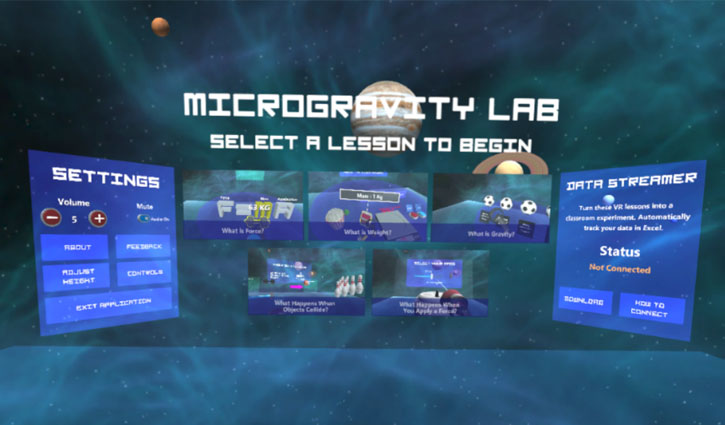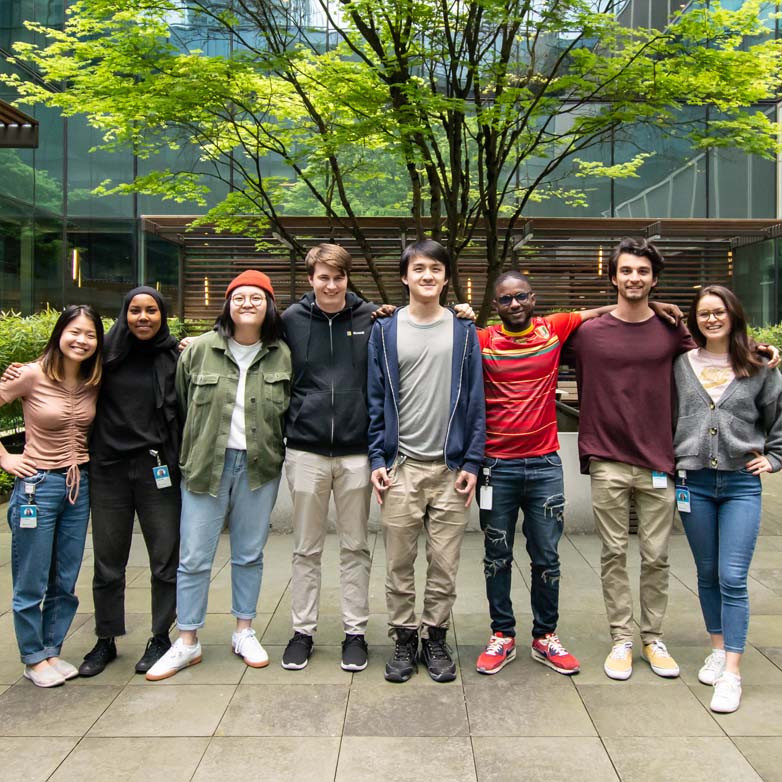Virtual reality can transport us to new lands that are near, far, or imagined. As a team of Garage interns found partnering with the Microsoft Hacking STEM and NASA Stem on Station teams, it can also demonstrate physics concepts and spark an interest in STEM careers. For the back-to-school season, we’re excited to announce the opportunity to try Microgravity Lab, a Microsoft Garage project. The VR experience for Windows Mixed Reality and corresponding lesson plan equip teachers with an engaging tool for teaching physics concepts by simulating microgravity. Interested educators can request an invite to try the VR application and corresponding lesson plans. Be sure to include your school name and plan for using the application into the form.
Bringing space into the classroom via Windows Mixed Reality
The Garage Internship is a unique, startup-style program in which teams of interns build projects in response to pitched challenges by Microsoft engineering teams. When this Vancouver intern team heard that the Microsoft Education team was looking for a creative new method way to illustrate the concept of microgravity through VR, they jumped at the opportunity to work on the project.
 An often-misunderstood concept, microgravity is difficult to simulate and understand in Earth’s gravity-laden environment. It is best explained through experiential learning. The Microgravity Lab VR lab experience for Windows Mixed Reality and its accompanying lessons gives teachers the tools to bring this experiential learning to their students.
An often-misunderstood concept, microgravity is difficult to simulate and understand in Earth’s gravity-laden environment. It is best explained through experiential learning. The Microgravity Lab VR lab experience for Windows Mixed Reality and its accompanying lessons gives teachers the tools to bring this experiential learning to their students.
As NASA Education Specialist Matthew E. Wallace shared, “The concept of microgravity is often misunderstood by students who learn about astronauts on the International Space Station. Providing a virtual reality world for them to explore the phenomena of life on orbit is an excellent way to engage students and solidify their comprehension of concepts related to force, mass and gravitational acceleration.”
Sabrina Ng, Design Intern for the project noted, “When I think of microgravity, I think of it as something you feel, not what you see per se. Thinking about how to visualize and communicate such an abstract concept without stimulating the physical senses was a really cool challenge.”
Microgravity Lab joins a collection of eight middle school lesson plans developed in partnership with NASA to celebrate 20 years of humans living in and working on the International Space Station.
Experiencing microgravity to understand Newton’s 2nd & 3rd Law
Microgravity Lab is designed for grades 6-8. Students can explore three VR modules to understand these physics principles in the context of microgravity on the moon:
- Conservation of momentum
- Newton’s 2nd Law
- Newton’s 3rd Law
The team worked closely with teachers to develop the project, testing early versions of Microgravity Lab with 7th and 8th grade classes. They refined and updated the experienced based on the classroom feedback.
Implementing feedback from teachers and students, the interns added a feature to enable live Microgravity data analysis via Excel. “This project gives students the experience and the fun aspects of VR, but with Excel, we found a way to expose them to Data Analysis. Data is a very important part of our world and this is a great way to introduce it to them,” shared Rébecca Vézina-Côté, the Program Manager Intern for Microgravity Lab.
Introducing space into the classroom via Windows Mixed Reality
Hacking STEM to engage students
Microgravity Lab joins the Hacking STEM portfolio. The portfolio is created by teachers for teachers to offer hands-on, inquiry-driven, real-world lesson plans. The standards-aligned, interdisciplinary lessons lesson plans teach 21st century technical skills in the context of existing curricula. The Hacking STEM portfolio now includes 22 middle and high school lesson plans built by teachers for teachers on topics ranging from circuits and robotic hands to learning how sharks swim, and now, microgravity.
“There are companies moving towards commercializing space travel and package delivery, a project like this might give students an idea of what life might be like on a space station, and hopefully inspire them to want to go further with it and see it as a future path for them as an area of interest or a future career,” shared Adrian Pang, a Software Engineer Intern with the project.
The Microgravity Lab experience makes science more engaging and introduces these concepts to students in a way that inspires lifelong learning and passionate curiosity about the world around them.
The impact of VR in the classroom
 The Microsoft Education team has provided materials to enable a seamless introduction of VR to the classroom. When immersive technologies are deployed correctly and in a pedagogically consistent manner, they have the potential to support and expand curriculum, enhancing learning outcomes in ways that haven’t been previously affordable or scalable. Read more in this white paper detailing the impact of VR in the classroom.
The Microsoft Education team has provided materials to enable a seamless introduction of VR to the classroom. When immersive technologies are deployed correctly and in a pedagogically consistent manner, they have the potential to support and expand curriculum, enhancing learning outcomes in ways that haven’t been previously affordable or scalable. Read more in this white paper detailing the impact of VR in the classroom.
Based on their own experience learning VR and Windows Mixed Reality, Garage interns have suggestions on how teachers can get started with VR. “Windows Mixed Reality does a great job of walking users through setting up the headset, then it’s just finding the app on the Microsoft Store, downloading it and installing it,” shared Rébecca. Crystal Song, another Software Engineering Intern continues, “I’d encourage teachers and school administrators to not see the tech as just a toy, but something that can teach. VR has a unique ability to teach through discovery, so allowing space and time for students to explore is key.”
James Burke, a longtime Hacking STEM developer partner who worked with the interns to test the project, encourages fellow educators to think outside the box to engage and challenge students. “Kids can do a lot more than people give them credit for.” In Burke’s engineering lab at Tyee Middle School, students work on project-based learning modules that can resemble college-level multidisciplinary assignments. With future-ready equipment and real-world projects to tackle, his award-winning classroom engages with students at every level. VR is just another way to spark that passion in students.
Request an invitation to try the project
To get started with Microgravity Lab for your classroom, request an invite to try the VR application. Include your school name and plan for using the application into the form.
More lesson plans and classroom materials are available at the Hacking STEM website.







